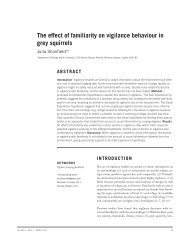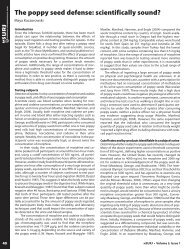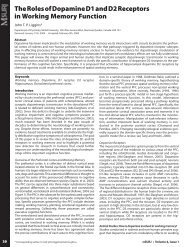the entire issue - McGill Science Undergraduate Research Journal ...
the entire issue - McGill Science Undergraduate Research Journal ...
the entire issue - McGill Science Undergraduate Research Journal ...
You also want an ePaper? Increase the reach of your titles
YUMPU automatically turns print PDFs into web optimized ePapers that Google loves.
REVIEW ARTICLE<br />
Operational transformation in cooperative<br />
software systems<br />
Clarence Leung 1 *<br />
1<br />
School of Computer <strong>Science</strong>, <strong>McGill</strong> University, Montreal, QC<br />
*Email Correspondence:<br />
clarence.leung@mail.mcgill.ca<br />
Abstract<br />
Modern cooperative software systems involve multiple concurrent users undertaking a common task<br />
in a real-time distributed environment, such as editing a shared text document. Maintaining data<br />
consistency, transaction causality, and replication convergence in such an environment, while providing<br />
fast client responsiveness, is a substantial challenge for classical distributed computing techniques.<br />
Operational transformation (OT) is a class of concurrency algorithms and data models that supports <strong>the</strong>se<br />
functionalities, which has drawn signicant research attention in <strong>the</strong> past decade. In this review, we discuss<br />
<strong>the</strong> basic components of operational transformation models, <strong>the</strong> algorithms involved, and <strong>the</strong>ir actual<br />
implementations in real-world networked systems. We compare several existing OT control algorithms,<br />
<strong>the</strong> transformation functions and properties supported by each of <strong>the</strong> algorithms, and <strong>the</strong> trade-offs that<br />
are made with respect to each one. The data and operational models used in OT are well suited for highlatency<br />
environments such as <strong>the</strong> Internet, making <strong>the</strong>m more frequently used in modern web services.<br />
Although many different OT control algorithms exist, choosing <strong>the</strong> most effective one often depends on<br />
<strong>the</strong> particular operations that an application must support.<br />
Introduction<br />
<strong>Research</strong> in computer-supported cooperative work (CSCW) in <strong>the</strong><br />
past decade has led to <strong>the</strong> development of many new collaborative<br />
web services, such as blogs, wikis, and social networks. These services<br />
can span from only a few simultaneous clients over a local network,<br />
to millions of daily users worldwide. Handling <strong>the</strong> availability<br />
of <strong>the</strong>se services becomes more difficult at a larger scale, especially<br />
in modern web applications, where notifications of user actions must<br />
be delivered in near real-time (1, 4, 7).<br />
However, a common problem that arises when engineering real-time<br />
applications, such as collaborative editing services like Google Docs,<br />
is to find <strong>the</strong> appropriate way to handle conflict resolution due to<br />
multiple concurrent users. Traditional (pessimistic) approaches to<br />
concurrency prevent conflicts from occurring by locking a resource<br />
while a client is accessing it, but doing so leads to slower application<br />
responsiveness as multiple users are unable to modify a document<br />
simultaneously. O<strong>the</strong>r approaches to concurrency, such as optimistic<br />
concurrency techniques, assume that data contention is rare, and eschew<br />
locks in favour of repairing conflicts when <strong>the</strong>y occur. However,<br />
in real-time applications, conflicts are common, and thus simple<br />
optimistic concurrency techniques cannot be used without hurting<br />
performance while repairing broken states.<br />
A new class of optimistic (non-locking) algorithms and data structures,<br />
known as operational transformation (OT), has been highly<br />
researched in <strong>the</strong> past decade in solving <strong>the</strong>se conflict resolution<br />
problems. OT algorithms function by considering all user-submitted<br />
actions as units known as “operations”, and handle any operations<br />
that conflict with each o<strong>the</strong>r by changing <strong>the</strong>ir properties relative<br />
to <strong>the</strong> changes that have already been applied to a particular document.<br />
In this paper, we formally discuss <strong>the</strong> characteristics of real-time web<br />
applications, as well as <strong>the</strong> models required for us to properly verify<br />
that our documents are consistent. Using <strong>the</strong>se models, we describe<br />
<strong>the</strong> operational transformation approach in detail, and survey several<br />
different approaches to OT that have been developed.<br />
Traditional web approaches<br />
Traditional web services handle client concurrency through <strong>the</strong> basic<br />
request/response model provided by HTTP, an asymmetric protocol.<br />
Request/response paradigms work by not having any response<br />
until a client specifically initiates a request to a web server, so no<br />
information is passed directly from <strong>the</strong> server to <strong>the</strong> client even if<br />
new updates have occurred on <strong>the</strong> server (7).<br />
This protocol would be successful in applications that did not re-<br />
62<br />
<strong>McGill</strong> <strong>Science</strong> <strong>Undergraduate</strong> <strong>Research</strong> <strong>Journal</strong> - msurj.mcgill.ca









